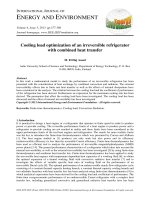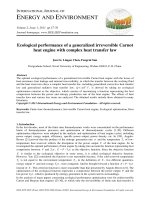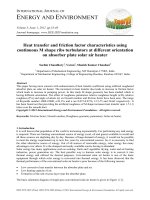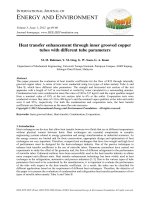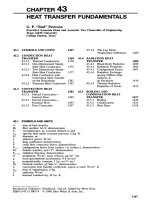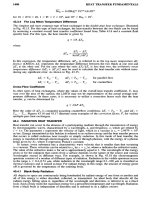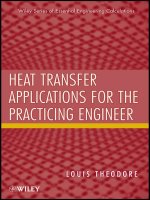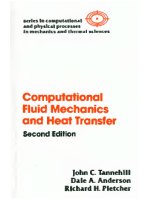Heat transfer enhancement through inner grooved copper tubes with different tube parameters
Bạn đang xem bản rút gọn của tài liệu. Xem và tải ngay bản đầy đủ của tài liệu tại đây (1.55 MB, 12 trang )
I
NTERNATIONAL
J
OURNAL OF
E
NERGY AND
E
NVIRONMENT
Volume 3, Issue 1, 2012 pp.49-60
Journal homepage: www.IJEE.IEEFoundation.org
ISSN 2076-2895 (Print), ISSN 2076-2909 (Online) ©2012 International Energy & Environment Foundation. All rights reserved.
Heat transfer enhancement through inner grooved copper
tubes with different tube parameters
M. M. Rahman, Y. M. Ling, G. W. Soon, G. A. Kuan
Department of Mechanical Engineering, Universiti Tenaga Nasional, Putrajaya Campus, 43009 Kajang,
Selangor Darul Ehsan, Malaysia.
Abstract
This paper presents the evaluation of heat transfer coefficients for the flow of R22 through internally
grooved copper tubes. A series of tests were conducted using two types of tubes namely Tube A and
Tube B, which have different tube parameters. The straight and horizontal test section of the test
apparatus with a length of 3.67 m was heated or cooled by water circulated in a surrounding annulus.
Condensation tests were conducted at mass flux rates of 180 to 537 kg/m
2
s and the vapor qualities ranged
from a nominal value of 83% at the test section inlet to 6% at the outlet. Evaporation tests were
conducted at mass flux rates of 110 to 404 kg/m
2
s and the nominal vapor qualities at the inlet and outlet
were 0 and 85%, respectively. For both the condensation and evaporation tests, the heat transfer
coefficients are found to increase as the mass flux rate increases.
Copyright © 2012 International Energy and Environment Foundation - All rights reserved.
Keywords: Inner grooved tubes; Heat transfer; Condensation; Evaporation.
1. Introduction
Heat exchangers are devices that allow heat transfer between two fluids that are at different temperatures
without physical contact between them. Heat exchangers are essential components in complex
engineering systems related to energy generation and energy transformation in industrial scenarios. As
the energy sources are limited and for their conservation, appropriate design and optimization of heat
exchangers are very important. Therefore, compact heat exchangers that have low-weight and high level
of performance must be designed for the heat-exchanger industry. One of the passive techniques to
enhance heat transfer coefficient is the use of microfin tubes. Numerous researchers have carried out
experiments to study the effect of fin geometry and, the flow of different refrigerants to the performance
of microfin tubes. Enhanced surfaces have been successfully used in the heat transfer industry to obtain
more compact and efficient units. Heat transfer enhancement technology has been widely used in heat
exchanger in the refrigeration, automotive and process industries [1-3]. Due to the various types of tube
parameters that need to be considered by the manufacturers, it is important to evaluate the performance
of the tube with respect to the heat transfer coefficient. As a result, the tubes can be classified for
different applications based on the requirement of different heat exchangers. Therefore, the objective of
this paper is to present the evaluation of condensation and refrigeration heat transfer performances of two
types of mirofin tubes namely Tube A and Tube B.
International Journal of Energy and Environment (IJEE), Volume 3, Issue 1, 2012, pp.49-60
ISSN 2076-2895 (Print), ISSN 2076-2909 (Online) ©2012 International Energy & Environment Foundation. All rights reserved.
50
2. Literature review
Heat transfer continues to be a major field of interest to engineering and scientific researchers, as well as
designers, developers, and manufacturers. The heat transfer enhancement has been analyzed by various
methods in order to have compact heat exchangers. Numerous researchers [4-17] have proposed
condensation heat transfer and pressure drop correlations for inner grooved tubes. Newell and Shah [18]
reviewed the characteristic of two-phase heat transfer, pressure drop, and the effect of void fraction in
inner grooved tubes. Valladares [19] reported that additional work was needed to develop a generalized
heat transfer correlation for inner grooved tubes. Wang and Honda [20] evaluated the existing
condensation heat transfer correlations for inner grooved tubes with their collected experimental heat
transfer data. Wang et al. [21] compared the condensation frictional pressure drop correlations for inner
grooved tubes and reported that the Goto et al.’s [7] correlation showed the best results even though it
does not consider any geometrical effects.
Ligrani et al. [22] have compared heat transfer augmentation techniques. Heat transfer augmentation
techniques for several geometries and boundary conditions have been examined in previous works and
reported in [23-25]. There have been some works on grooved surfaces in channels or tubes [26-28]. The
heat transfer increase and pressure drop in the helically grooved, horizontal micro-fin tubes were
investigated by Wang et al. [27]. Many kinds of internally grooved tubes have been investigated to
improve the performance of air-conditioning heat exchangers for HFC refrigerants [7]. Park & Choi [26]
have shown that grooved or fluted tubes are widely used in modern heat exchangers. Brognaux et al. [29]
expressed heat transfer and friction characteristics for single-phase flow in single-grooved and cross
grooved micro-fin tubes. They have found that the microfin tubes have enhanced heat transfer to as high
as 1.8 times that of smooth tubes. Three dimensional flow and augmented heat transfer in a
symmetrically grooved channel have been analyzed by Greiner et al. [30]. They have carried out their
analysis for a Reynolds number variation of 180-1600 with constant temperature boundary condition.
Considerable efforts are also devoted in order to determine heat transfer coefficient for evaporation by
using different shape of fins [31-42].
Evaporation and condensation heat transfer inside of an internally grooved horizontal tube were
measured and reported that local heat transfer coefficients of the herringbone-grooved tube were about
twice as large as those of the spiral-ribbed tube for condensation and only slightly larger for evaporation
[7]. A smooth tube and an internally ribbed tube were compared for flow boiling heat transfer
performance [43]. The spirally, internally ribbed tube gave 1.4 - 2 times the heat transfer coefficient and
about the same increase in two phase pressure drop. A horizontal, microfinned tube was evaluated for
evaporation performance [44]. There was a noted improvement with microfinning over the performance
of the smooth tube. Evaporation of R-134a in a heated capillary tube was experimentally documented
[45]. A correlation predicting the under-pressure of vaporization for capillary tube was developed.
Survival of a vapor bubble within a macrochannel was described [46].
3. Materials and method
This section consists of several subsections highlighting the materials used during the test and the
experimental procedure to evaluate the heat transfer coefficients of internally grooved copper tubes.
3.1 Test facility
The test used to conduct this study is capable of measuring in-tube average and local heat transfer
coefficients for a variety of refrigerants and flow conditions. The test facility has four main parts, i.e, (i) a
test section, (ii) a refrigerant loop, (iii) a water loop, and (iv) a data acquisition system. The following
sections give detailed description of these four main parts of the test facility. A schematic drawing of the
test facility is shown in Figure 1.
3.2 Test section
The test section is a tube-in tube counter flow heat exchanger. The test tube is the inner tube of the heat
exchanger. The diameter of the inner tube can be varied depending on the size of the tube is being tested,
however the tube length is 3.67 m. The annulus, surrounding of the refrigerant tube, is also 3.67 m long
with an inner diameter of 17.2 mm. Two tubes namely Tube-A and Tube-B with different parameters are
tested. Details of the tube parameters are depicted in Table 1. The inner tube is centered and secured in
the annulus by a series of spacers. The water in the annulus flows counter to the refrigerant flow and is
used to heat or cool the refrigerant depending on the test that is being performed. For example, in the
International Journal of Energy and Environment (IJEE), Volume 3, Issue 1, 2012, pp.49-60
ISSN 2076-2895 (Print), ISSN 2076-2909 (Online) ©2012 International Energy & Environment Foundation. All rights reserved.
51
case of evaporation in this study, the water heats the refrigerant. The exterior of the annulus is insulated
with a thick layer of foam insulation that ensures negligible energy loss from the heat exchanger to the
environment during testing. The temperatures are measured with resistance temperature devices (RTDs),
which have a manufacturer’s uncertainty of ±0.05°C.
Figure 1. Schematic of the test facility
Table 1. Details of the tubes
Tube Parameter Tube A Tube B
Outer diameter, d
o
(mm) 7.00 7.00
Inner diameter, d
i
(mm) 6.50 6.36
Number of grooves, n 50 55
Groove height, h (mm) 0.21 0.20
Apex angle,
γ
40º 20º
Helix angle,
α
18º 20º
Bottom wall thickness (mm) 0.25 0.32
Total wall thickness (mm) 0.46 0.52
Unit weight (g/m) 61 70
3.3 Refrigeration loop
The refrigerant loop consists of an after-condenser, a positive displacement pump, an accumulator, a
boiler, and a super-heater. The after-condenser is a co-axial heat exchanger, which condenses and sub-
cools the refrigerant leaving the test section. The water-glycol mixture for the heat exchanger is provided
by a 300 gallon storage tank that is cooled to a preset temperature by the lab’s centralized 30 ton nominal
chiller. After being sub-cooled, the refrigerant is circulated by a positive displacement pump. The flow
rate of the refrigerant is controlled by two valves. One valve restricts flow to the test section and another
International Journal of Energy and Environment (IJEE), Volume 3, Issue 1, 2012, pp.49-60
ISSN 2076-2895 (Print), ISSN 2076-2909 (Online) ©2012 International Energy & Environment Foundation. All rights reserved.
52
valve allows refrigerant to flow through a bypass loop to the condenser. By using these two valves in
combination, the flow rate can be set.
The accumulator controls the pressure in the test section, and also helps to dampen out pressure
fluctuations that may occur in the system. The quality of the refrigerant entering the test section is set by
a heater located directly upstream of the test section. The heater consists of a 12.7 mm outside diameter
by 2.63 m long stainless steel tube heated by direct current. The heater is electrically isolated from the
rest of the system by a high pressure rubber hose. Directly upstream from the boiler is a superheater,
which consists of a heat tape wrapped around a 3/8-inch diameter copper tube. For this study, the
superheater was not used. The refrigerant mass flow rate is measured by a coriolis type mass flow meter
accurate to 0.15% of the mass flow rate plus 2.25e-05 kg/s.
3.4 Water loop
The water loop consists of a centrifugal pump, an in-line electric heater, and a heat exchanger. The mass
flow rate is controlled by a valve that restricts the flow of water. The temperature of the water entering
the test section is controlled by the electric heater and the heat exchanger, which uses building’s supplied
chilled water to cool the water in the test loop. The water mass flow rate is measured by a coriolis type
flow meter with an accuracy of 0.15% of the mass flow rate plus 2.25e-04 kg/s.
3.5 Data acquisition
Data acquisition is accomplished by a personal computer, a 40 channel scanner, and a multimeter. The
controlling program on the personal computer is written in FORTRAN and controls the multimeter and
the scanner via an IEEE-488 bus.
3.6 Experimental procedure
The test facility is allowed to reach steady state before final data acquisition is started. This is achieved
by manually adjusting the mass flow rates, the boiler power, and the annulus water temperatures until the
desired test conditions have been achieved. The data acquisition systems scan for temperature, mass flow
rate, and pressure fluctuations. When the fluctuations are minimal, the final data acquisition program is
run. During final data acquisition, each of the channels is scanned to a total five times except for
pressure, which is scanned 35 times because of pressure drop fluctuations. The scans of each channel are
then averaged and used in the data analysis to calculate the results. If any large deviations due to
unsteady effects are detected, the run is aborted.
4. Data analysis
Raw data from the data acquisition system are analyzed for each run to determine the in-tube convective
heat transfer coefficient and the quality change. The main equations used in processing the raw data are
based on energy balance. The energy transferred in the test section is computed from an energy balance
on the water side,
( )
inwoutwwpww
TTcmq
,,,
−=
(1)
This energy transfer is then used to determine the quality change of the refrigerant in the test section by
using the following equation,
fgr
w
hm
q
X
=∆
(2)
The vapor quality entering the test section is calculated from an energy balance on the refrigerant boiler.
The heat output from the boiler, q
h
, is calculated from voltage and current readings. The heat input to the
refrigerant takes two forms, sensible and latent, which can be expressed as:
( )
inhsatrrprsens
TTcmq
,,,
−=
(3)
International Journal of Energy and Environment (IJEE), Volume 3, Issue 1, 2012, pp.49-60
ISSN 2076-2895 (Print), ISSN 2076-2909 (Online) ©2012 International Energy & Environment Foundation. All rights reserved.
53
outhfgr
Xhmq
lat
,
=
(4)
The saturation temperature of the refrigerant entering the boiler is determined from the pressure of the
refrigerant entering the test section. Equations 3 and 4 are used to determine the quality of the refrigerant
entering the test section where the outlet quality of the heater, X
h,out
, is equal to the inlet quality of the test
section, X
in
as,
()
⎭
⎬
⎫
⎩
⎨
⎧
−−=
inhsatrp
r
h
fg
in
TTc
m
q
h
X
,,
1
(5)
The refrigerant side heat transfer coefficient is determined from the overall heat transfer coefficient and
the annulus side heat transfer coefficient, h
o
, which is determined using the modified Wilson plot
technique [43]. The overall heat transfer coefficient is determined from the energy balance on the test
section as,
lmo
w
o
TA
q
U
∆
=
(6)
The log mean temperature difference,
()
lm
T
∆
from the inlet and outlet temperatures on both the water
and refrigerant sides is,
⎟
⎟
⎠
⎞
⎜
⎜
⎝
⎛
∆
∆
∆−∆
=∆
2
1
21
ln
T
T
TT
T
lm
(7)
where
inwoutr
TTT
,,1
−=∆
(8)
outwinr
TTT
,,2
−=∆
(9)
Assuming the negligible thermal resistance of the copper tubing, the refrigerant side heat transfer
coefficient is then determined as,
⎟
⎟
⎠
⎞
⎜
⎜
⎝
⎛
⎟
⎟
⎠
⎞
⎜
⎜
⎝
⎛
−
=
o
i
oo
i
A
A
hU
h
11
1
(10)
The heat transfer coefficient determined in this equation is an average value over the whole length of the
tube.
5. Results and discussions
This section covers the presentation of key findings on the heat transfer enhancement through internally
grooved copper tubes.
5.1 Convection heat transfer coefficient
Two types of experiments, i.e., condensation test and evaporation test are conducted in order to
determine the water side heat transfer coefficient (h
o
), as well as refrigerant side heat transfer coefficient

